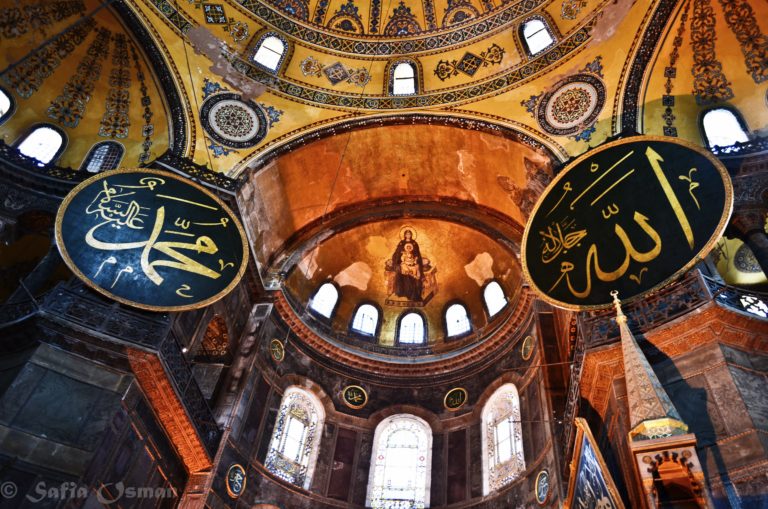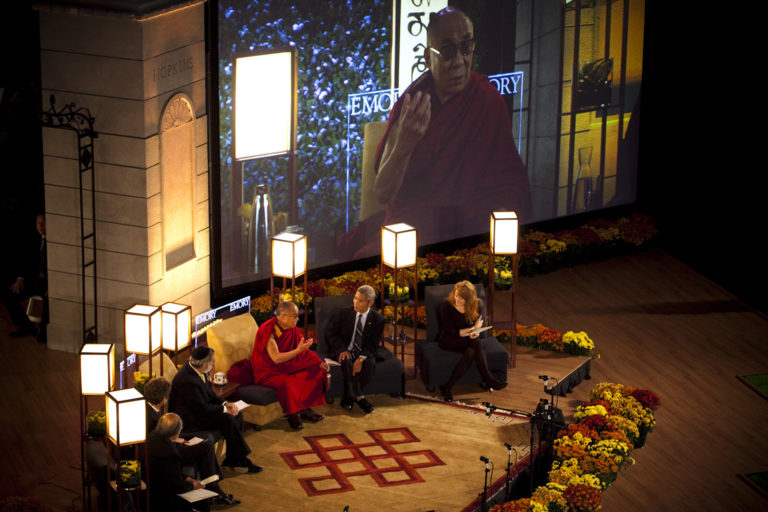
The Apsis of Hagia Sophia, a basilica-turned-mosque-turned-museum in Istanbul, Turkey. Image by Safia Osman/Flickr, Some Rights Reserved.
A Theology of Cracked Spaces: A Confluence of Traditions to a Confluence of Spirit
Last year, around this time, I wrote a column about Muslims celebrating the birthday of the Prophet Muhammad, a festival known as the Mawlid. This time around, the heavenly intimacy of Jesus and Muhammad shows up in the earthly calendar. Most Muslims are going to be honoring the birthday of the Prophet, the Mawlid, on December 24. Most Christians are going to be honoring the birthday of Jesus Christ on December 25. Jesus and Muhammad, here on Earth as they are in heaven.
In today’s world of conflict, the closeness of the birthdays of Muhammad and Jesus brings me joy. For a few brief days, I hope and pray that Muslims and Christians will look at this fortuitous intimacy as a reminder of the spiritual closeness of these two beautiful religious traditions.
Jesus and Muhammad. Muhammad and Jesus. In the Muslim imagination, the two bear an intimate relationship: Christ is depicted as foreshadowing the coming of Muhammad, and, during his heavenly ascension (the Mi‘raj), Muhammad meets with Jesus.
There are deeper analogies, too, for those who are inclined towards profound spiritual and theological parallels and commonalities, in place of zero-sum theological claims. In the Christian tradition, Christ is the Logos, the word of God — trusted to the womb of Mary, which has to be “virginal” to receive the Logos. In Islam, it is the Qur’an that is the Logos, the word of God. The word of God — in this case the Qur’an — has to be trusted to the “virginal” heart of Muhammad, which like the womb of Mary has to be pure to receive God’s words. In other words, Jesus and Qur’an both function as the Logos, trusted in turn to Mary’s womb and Muhammad’s heart.
The story of Jesus’ birth is one of the key narratives in the Qur’an. The Virgin Mary is, bar none, the most significant female character in the Qur’an. In fact, God uses the very same pronouns for Mary in the Qur’an (“chosen you and purified you”) that are used to describe the loftiest adjective assigned to the Prophet Muhammad (“Mustafa”).
The Qur’anic description of Jesus’ birth puts Mary at the center, as Muhammad’s mother Amina is at the center of the Mawlid (Qur’an 3:45):
Behold! the angels said: “O Mary! God gives you the good news of a Word from Him:
his name will be Christ Jesus, the son of Mary,
held in honor in this world and the Hereafter
and of (the company of) those nearest to God…”
The Qur’anic narrative for Mary and Jesus is so elaborate, much more than the biblical canonical one, that it forms one of the models of intimacy with God, trust, tenderness, and God mingling with the vulnerable. Those same traits are picked up by Muslim poets like Rumi who uses Mary giving birth to Jesus as a metaphor for how each and every single one of us carry inside us the spirit of God, our own personal Jesus. But in order for us to “give birth” to the Jesus of our spirit, we have to become like Mary, willing to endure the birth pangs of the spiritual path.
Here is what Rumi says in his wonderful text Fihi ma fihi, translated as “Signs of the Unseen”:
Nothing can be undertaken until a pain
—a yearning and love for a thing—
is awakened inside a human being.Without pain one’s endeavor will not be easy,
no matter whether it be about this world,
the hereafter,
commercial, regal, scholarly, astrological
or anything else.
Our body is like Mary,
and each of us bears a Jesus.If we experience birth pains,
our Jesus will be born,but if there is no pain,
our Jesus will return to his origin
by that hidden road whence he came,and we will remain deprived.
It’s well-known that devotion to Virgin Mary was at the heart of Christian piety for the first millennium and half of Christianity. Far less known is that Muslims too have had their own devotion to the Virgin. There is a profound living tradition of Muslim women recalling the Virgin Mary at the moment of giving birth, identifying with the suffering of Mary — and her faith in God — in that moment. Some years ago a friend of mine named Seemi Ghazi, perhaps known to listeners of On Being, wrote a beautiful essay about this confluence.
Admittedly, not all of my thoughts about Jesus these days come from the Bible and the Qur’an.
The imagery around Jesus’ birth takes us to a manger. I do think about Mary these days — not in terms of a virgin birth, but in terms of single motherhood. I wonder if we would recognize Jesus in face of a homeless child, in the experience of a single mother.
How can I escape the poignant symbolism of Mary and her family fleeing as refugees at a time where millions of refugees are fleeing the Middle East? How can I not see the spirit of God in these millions of refugees? How can I walk past the nativity scenes all around me, without wondering about where today’s “least of these” are. This Mawlid, this Christmas, this year of ISIS and refugees and Paris and Baltimore and Charleston, and Nigeria and Syria and Iraq and…
I wonder if those who call themselves followers of Christ and Muhammad would open not just their hearts but also their physical homes to those refugees who today find themselves homeless. Oh, how the birth of Jesus, a refugee, and Muhammad, an orphan, reminds me of the Christian-majority societies that are talking about turning away refugees and Muslim-majority societies that haven’t done their part.
I find myself in a moment of pausing and looking back at Jesus’ manger. The God of the whole cosmos shows up in the humblest of places. This is a theology of cracked spaces, of broken places, and of the healing of God’s presence.
I don’t know about the levels and layers of heaven,
but I do know about tenderness
about curves of a baby’s bottom
about the touch of a loved one
about wrinkles
about dirt
about sunshine
about wild geese
about waterfalls
about mountains
and about a God who is here with us
and above
intimate with those whose brokenness
has become an opening for Him to enter.
This is a God
who is not just the God of the majesty and the mighty,
but a God of the broken down,
the poor,
the refugee.
This is a God is less the Prime Mover
and more the Most Moved Mover.
I am thinking about the land of Jesus’ birth, about the tiny village of Bethlehem. My thoughts go to Bethlehem, a village that is today, as it has been for the past 48 years, under occupation. I wonder about how Jesus was both a Palestinian and a Jew, identities that in today’s bizarre world we come to imagine as being diametrically opposed. I wonder about how Jesus’s journey through the biblical landscape we know so well (Bethlehem, Jerusalem, Nazareth) would be all but impossible today, given the many roadblocks, settlements, and roads that connect them.
The great graffiti artist Banksy has in fact depicted this very poignant scene. My love for Jesus and Muhammad forces me to lead with the weak, the marginalized, the dispossessed, the disenfranchised today.
Yes, I come back to the mangers of the world,
Of the brokenness that invites God to where He has been all along.
I come back to Jesus and Muhammad
and wonder if can sit with them both
Welcoming them into this world
into our hearts
Welcoming the One whose light they both reflect
One light
One love
One God.


Share your reflection